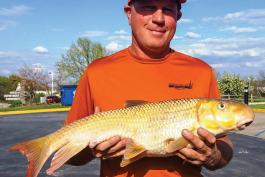Dan Schmitz watched the tip of his fishing pole jiggle over Tavern Creek’s silty water in Miller County. He waited until the jiggles became insistent tugs, then tightened the line and hauled back on his rod, hooking the unseen fish.
“It feels like a good one,” he said. When the fish surfaced, he said, “It’s a carp.” I sensed a little regret, but only a little. The fish had given him a good fight. For a moment it also had given him hope that he might have hooked a new state-record river redhorse.
On that mid-May morning, Schmitz already held the pole-and-line record for a 9-pound, 13-ounce redhorse he caught from the same deep eddy a month earlier. But that catch had heightened his interest in this “niche fish.”
Getting Hooked is Easy
These nongame fish — suckers, shad, herring, drum, and carp — are exclusive in a way because few anglers pursue them. Schmitz targets niche fish, but more often than not, people catch these fish by accident while angling for more popular game species. The first Missouri fishing record of 2016 is a good example.
On Jan. 8, Shane Doherty of Ft. Scott, Kansas, crossed the state line to fish for crappie in a strip mine pit in Vernon County. He was retrieving a pink jighead with a white plastic body when he felt a tug on his 4-pound-test line.
“When I first saw it, I thought I had a big crappie,” Doherty recalls, “but then I got a good look, and it was huge!
It turned out to be a gizzard shad, and it was huge for its species — 2 pounds, 2 ounces, and nearly 20 inches long.
Or take the case of Brent Newton, Holts Summit. He and his son were bouncing worms along the bottom of the Osage River downstream from Bagnell Dam on March 5, 2016, hoping to catch a mess of catfish for supper. He hooked what he initially thought was a bass, but then he got it in the boat.
“It looked like a shad, but my son used his phone to look it up, and we decided it was a skipjack herring. It was big enough that it might have been a record, so he sent a photo of it to the Conservation Department. They said it was a goldeye. I never even heard of that. When we took it in to be weighed, it was 2 pounds — a record.”
Clearly, you don’t have to be an expert to catch niche fish. You don’t even have to try. Imagine what you might be able to catch if you did.
What Are Niche Fish?
For this article, let’s focus on suckers, carp, herrings, mooneyes, and drum. These groups include dozens of species. Even within a group, such as carp, various species’ habits and the techniques used to catch them differ considerably. We can’t possibly cover all of them here, but the following information will help you get started taking them with pole and line, gear you most likely already have.
Angling for a Record
Because niche fish receive so little attention, many records are not very big. Others have never been entered. Consequently, these species are ripe for record-setting. Take a picture of a possible record fish and send it to the nearest Conservation Department office for identification. Current record weights are available on the Fishing Records Page at short.mdc.mo.gov/Zk9. If your fish seems big enough to qualify, contact the local conservation agent or call a Conservation Department regional office and arrange to have your fish officially weighed. Keep it in cool, well-aerated water or put it on ice to minimize weight loss.
Suckers
This group includes the quillback, redhorses, and buffalo fishes. Suckers are easiest to catch in early spring during annual spawning runs when large numbers congregate in shallow, gravel-bottomed areas with some current. You can continue to catch suckers after the spawning run in late spring and summer when they haunt deep pools and shallows next to deeper water.
Suckers, buffaloes, and redhorses all have small mouths, so you should use No. 6 or smaller hooks. If you are after buffalo, stout hooks are in order. A big buffalo can straighten out a light wire hook. Night crawlers are excellent bait for these fish.
Quillback Record: 2 lbs, 12 oz
Carp
Technically, carp are large members of the minnow family, but their overgrowth is spectacular and some species have become invasive. Missouri’s alternative-methods record bighead carp, snagged at Lake of the Ozarks in 2011, tipped the scales at 106 pounds. The Conservation Department also keeps pole-and-line records on bighead, common, and grass carp. Each of these species is capable of testing heavy tackle and the person wielding it.
Bighead carp are filter-feeders, eating only plankton and stray bits of organic matter. Consequently, the only effective way to target them is snagging with treble hooks. Snagging bighead carp is easiest in the summertime when they form schools in the lower reaches of streams that feed the Missouri and Mississippi rivers.
The most popular bait for common carp is dough balls concocted from some combination of corn flakes, cornmeal, oatmeal, flour, and peanut butter. Dozens of recipes are available online.
Grass carp are my personal favorite of this group, partly because of their predictability and partly because of their size and strength. The pole-and-line record stands at 69 pounds, and even a 10-pound grass carp can strip 100 feet of line off your reel in less time than it takes you to say, “H-h-h-holy cow!”
To catch grass carp, check with a conservation agent or fisheries biologist to identify public lakes that have them and that allow chumming (some don’t). Next, fill two or three milk jugs with cracked corn. Add water, and let it ferment for a few days. Scatter fermented corn in the shallowest part of your chosen lake for two days before you plan to fish. On the third day, you will find grass carp looking for more corn in the baited area.
Use a slip-sinker rig with a stiff, No. 4 bait-holder hook. Cover the hook with canned whole-kernel corn or slip the hook inside a cherry tomato, and toss it into the baited area, then set your reel to free spool. When line begins to payout, wait until it stops, then starts again. That’s the time to set the hook and hold on for dear life.
Grass carp have grinding teeth at the back of their throats that can chew through monofilament line. Braided line is tougher than monofilament and is less likely to be felt by the fish. I recommend 20- or 30-pound line.
Your chances of catching common or grass carp are best early and late in the day. It is important to not let the fish feel any tension on the line until you are ready to set the hook. They will spit out food at the slightest hint of treachery.
Big carp fight long and hard, so you want a medium-weight fishing rod at least 7 feet long to help absorb the stress of fast, hard runs. Make sure your reel holds at least 150 yards of line, and set your drag light enough to prevent break-offs during lightning-fast runs.
Herrings
Only two species in this group — the skipjack herring and gizzard shad — are common and large enough to be on Missouri’s fishing records list. Their flesh is bony, oily, and flavorless, but they make superb live or cut bait for catfish.
Skipjacks can exceed 20 inches and 3 pounds. These schooling, migratory fish are most common in the Mississippi River south of the mouth of the Ohio River. However, schools of skipjacks occasionally visit the Current River and the Osage, Meramec, and other major tributaries of the Mississippi and Missouri rivers.
Minnows and other small fish make up the bulk of skipjacks’ diet. They often congregate below dams or in the swirling eddies around major river junctions. Sometimes they join white bass in feeding schools. If you find “skippers” feeding near the surface, tie two or three jigs on your line and cast into the melee. You will often bring back as many skipjacks as you have hooks. When hooked, they leap and skip along the surface, as their name implies.
The gizzard shad is similar in appearance and size to the skipjack. It is named for the muscular stomach that grinds up algae and tiny insect larvae that it eats. The gizzard shad is found in streams statewide. However, its food preference makes it difficult to catch on hook and line.
Mooneyes
Mooneyes and goldeyes are the only two species of this family found in Missouri. They look similar to gizzard shad, but with larger heads and eyes. Goldeyes are larger than mooneyes — up to 14 inches — and have gold-colored eyes, while the mooneye’s iris is mostly silver. Both species inhabit the Missouri and Mississippi rivers and their larger tributaries. However, mooneyes are uncommon outside of southeast Missouri. Smoked mooneye is considered a delicacy in Canada.
Both species are sight feeders on insects and other small animals. Their huge eyes allow them to see in low light, and most of their feeding is done between dusk and dawn, often at the surface. These feeding habits make fly-fishing an effective and sporty way to catch either species. Streamers and woolly bugger flies work well. So do in-line spinners and jigs. Look for them in 1 to 6 feet of water along riprapped banks on the Missouri River. They are common from the mouth of the Osage River to the old lock and dam just upstream from the Mari-Osa Access.
If you find a mulberry tree dropping its fruits into the water, you are likely to find goldeyes, skipjacks, and various carp slurping them down. Bait your hook with this natural “hatch,” or drop a black, mulberry-sized popping bug into the feeding zone. You might also hook a catfish this way.
Freshwater Drum
This fish is the only member of its family in Missouri. It is closely related to the red drum that inhabits the Gulf of Mexico and is fine table fare. Adults generally weigh 1 or 2 pounds, but the state pole-and-line record, caught at Lake of the Ozarks in 1980, weighed 40 pounds, 8 ounces. Drum are common in larger streams and reservoirs statewide, but they also turn up in smaller tributaries.
Fish, crayfish, and insects make up the bulk of drum food. They occasionally bite on artificial lures, but their bottom-feeding habit makes bait fishing the most productive strategy. Worms, crayfish, or minnows all are good drum bait.
Drum prefer deep water. On lakes, look for them 10 to 40 feet deep around creek mouths, submerged creek channels, and riprap banks adjacent to deep water. On rivers, look for them behind wing dikes, eddies, and deep pools near sandbars, and in dam tail waters.
Drum are school fish, so if you catch one, keep fishing where you are. Chances are good that you will catch several more.
Freshwater drum Record: 40 lbs, 8 oz
Find Your Niche
You don’t have to give up bass, bluegill, crappie, and trout to enjoy niche fishing. But give these nongame species a try if you find yourself in the mood for something different, or if you want to feel something bigger than a bass on the end of your line — say, a 30-pound drum.
Rigging for Niche Fish
When fishing with worms or other natural bait, it pays to remember three things:
- Use enough weight to keep your bait on or near the bottom.
- Use a slip-sinker rig to allow the fish to take the bait without resistance.
- Use a barrel swivel above the bait so your bait can spin in the current without twisting your line.










Also In This Issue


And More...
This Issue's Staff
Art Director - Cliff White
Associate Editor - Bonnie Chasteen
Staff Writer - Heather Feeler
Staff Writer - Kristie Hilgedick
Staff Writer - Joe Jerek
Photographer - Noppadol Paothong
Photographer - David Stonner
Designer - Les Fortenberry
Designer - Marci Porter
Designer - Stephanie Thurber
Circulation - Laura Scheuler






















